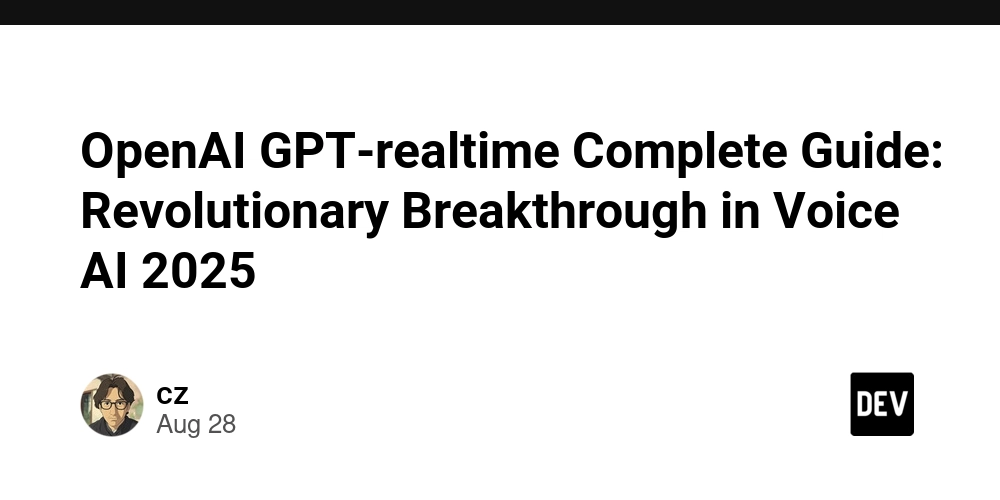🎯 Key Takeaways (TL;DR)
- Official Launch: OpenAI Realtime API is now generally available with the most advanced gpt-realtime model
- Performance Boost: New model shows significant improvements in instruction following, tool calling, and speech naturalness, with accuracy jumping from 65.6% to 82.8%
- Price Optimization: 20% price reduction compared to previous model – $32/1M audio input tokens, $64/1M audio output tokens
- Feature Expansion: Supports image inputs, SIP phone calls, remote MCP servers, plus two new exclusive voices: Cedar and Marin
- Production Ready: Optimized for real-world applications like customer service, education, and personal assistants, with EU data residency support
Table of Contents
- What is GPT-realtime and Realtime API?
- Core Technical Breakthroughs & Performance Improvements
- New Features Deep Dive
- Pricing Strategy & Cost Optimization
- Real-world Use Cases Analysis
- Developer Feedback & Challenges
- Competitive Analysis
- Frequently Asked Questions
What is GPT-realtime and Realtime API? {#what-is-gpt-realtime}
OpenAI’s GPT-realtime is a revolutionary speech-to-speech model delivered through the Realtime API. Unlike traditional voice processing pipelines, this system processes and generates audio directly without the complex chain of speech-to-text-to-speech conversion.
Traditional Voice AI vs GPT-realtime Comparison
| Feature | Traditional Voice AI | GPT-realtime |
|---|---|---|
| Processing Flow | Speech→Text→Processing→Text→Speech | Speech→Direct Processing→Speech |
| Latency | High (Multi-step) | Low (Single-step) |
| Speech Fidelity | Loses nuances | Preserves intonation & emotion |
| Development Complexity | Multiple APIs required | Single API |
💡 Technical Advantage
The Realtime API processes audio directly through a single model and API, significantly reducing latency while preserving speech nuances for more natural conversations.
Core Technical Breakthroughs & Performance Improvements {#technical-breakthroughs}
1. Significant Intelligence Enhancement
Big Bench Audio Evaluation Results:
- gpt-realtime (2025-08-28): 82.8% accuracy
- Previous model (Dec 2024): 65.6% accuracy
- Improvement: 26.3%
2. Dramatic Instruction Following Improvements
MultiChallenge Audio Benchmark:
- gpt-realtime: 30.5% accuracy
- Previous model: 20.6% accuracy
- Improvement: 48.1%
The model can now:
- Execute complex instructions precisely (e.g., “speak quickly and professionally”)
- Read disclaimer scripts word-for-word
- Accurately repeat alphanumeric sequences
- Switch languages seamlessly mid-sentence
3. Major Function Calling Accuracy Boost
ComplexFuncBench Audio Evaluation:
- gpt-realtime: 66.5% accuracy
- Previous model: 49.7% accuracy
- Improvement: 33.8%
Improvements include:
- Accuracy in calling relevant functions
- Better timing for function calls
- More precise function arguments
✅ Best Practice
The new asynchronous function calling feature allows the model to continue fluid conversation while waiting for long-running function results, requiring no additional developer code changes.
New Features Deep Dive {#new-features}
1. Image Input Support
Users can now add images, photos, and screenshots to voice conversations, enabling:
- Visual Q&A: “What do you see?”
- Text Recognition: “Read the text in this screenshot”
- Scene Understanding: Deep conversations based on image content
2. SIP Phone Call Integration
Through Session Initiation Protocol (SIP) support:
- Connect to public phone networks
- Integrate with PBX systems
- Support desk phones
- Other SIP endpoints
3. Remote MCP Server Support
Model Context Protocol (MCP) integration:
- Simply pass remote MCP server URL to enable
- API automatically handles tool calls
- No manual integration setup required
- Easy agent capability extension
4. New Exclusive Voices
Cedar and Marin:
- Available exclusively in Realtime API
- Significant improvements in naturalness
- Existing 8 voices also updated and optimized
5. Reusable Prompts
Developers can now:
- Save and reuse prompt templates
- Include developer messages, tools, variables
- Use example conversations across sessions
- Similar experience to Responses API
Pricing Strategy & Cost Optimization {#pricing-strategy}
Latest Pricing (20% reduction from previous model)
| Service Type | gpt-realtime | gpt-audio |
|---|---|---|
| Audio Input | $32/1M tokens | $40/1M tokens |
| Cached Input | $0.40/1M tokens | – |
| Audio Output | $64/1M tokens | $80/1M tokens |
New Cost Control Features
- Intelligent Token Limits: Fine-grained conversation context control
- Multi-turn Truncation: Truncate multiple conversation turns at once
- Long Session Optimization: Significantly reduce costs for extended sessions
💡 Cost Optimization Tip
Using the new context control features can reduce long session costs by 30-50%.
Real-world Use Cases Analysis {#use-cases}
1. Customer Service
Advantages:
- 24/7 availability
- Seamless multilingual switching
- Emotion recognition and response
- Precise complex instruction execution
Real Examples:
- Banking customer service automation
- E-commerce after-sales support
- First-level technical support
2. Education & Training
Applications:
- Language learning conversation practice
- Personalized tutoring
- Pronunciation assessment and correction
- Interactive course content
3. Personal Assistants
Feature Extensions:
- Schedule management and reminders
- Smart home control
- Real-time translation services
- Health monitoring conversations
4. Enterprise Internal Applications
Scenarios Include:
- Meeting recording and summarization
- Internal training systems
- Employee support hotlines
- Process automation
Developer Feedback & Challenges {#developer-feedback}
Positive Feedback
Based on Reddit and Hacker News discussions:
- Production Ready: Developers consider the new version production-grade
- Latency Improvements: Significant latency reduction widely acknowledged
- Feature Completeness: SIP support and MCP integration well-received
Remaining Challenges
1. Multilingual Recognition Issues
Finnish Developer Feedback:
- Heavy-accented English often misrecognized as Finnish
- Language recognition accuracy decreases after multiple conversation turns
- Language prompt instructions have limited effectiveness
⚠️ Caution
For non-native English speakers, especially those with pronounced accents, additional language specification strategies may be needed.
2. Open Source Competition Pressure
Industry Observations:
- Long-term, teams may prefer open-source solutions
- Core business dependency on closed APIs poses risks
- Need for speech-native, low-latency open-source alternatives
Competitive Analysis {#competition-analysis}
OpenAI vs Other Voice AI Solutions
| Provider | Advantages | Disadvantages | Use Cases |
|---|---|---|---|
| OpenAI GPT-realtime | End-to-end integration, low latency, production-ready | Closed source, high dependency | Enterprise applications |
| Google Gemini 2.5 Flash | Free usage, image processing capabilities | Relatively basic features | Prototype development |
| Open Source Solutions | High control, no vendor lock-in | Self-maintenance required, high technical barrier | Technical teams |
Market Positioning Analysis
OpenAI’s strategy through this release clearly positions them in the voice AI market:
- Enterprise Customer Acquisition: Targeting customer service, education, assistant applications
- Lower Barrier to Entry: 20% price reduction
- Complete Feature Set: One-stop solution approach
Safety & Privacy Protection {#safety-privacy}
Multi-layer Security Safeguards
- Active Classifiers: Real-time conversation content monitoring
- Content Violation Detection: Automatic interruption of violating conversations
- Developer Tools: Agents SDK provides additional safety guardrails
Privacy Policies
- EU Data Residency: Full support for EU data compliance requirements
- Usage Policies: Prohibits spam, deception, and other malicious uses
- AI Identity Disclosure: Requires clear notification when users interact with AI
✅ Compliance Recommendation
Using preset voices helps prevent malicious impersonation; recommend maintaining this setting in enterprise applications.
🤔 Frequently Asked Questions {#faq}
Q: What are the significant improvements of GPT-realtime compared to previous models?
A: Key improvements include: 1) 26.3% intelligence boost (Big Bench Audio test); 2) 48.1% improvement in instruction following; 3) 33.8% increase in function calling accuracy; 4) 20% price reduction; 5) Support for image inputs and SIP phone calls.
Q: What application scenarios is the Realtime API suitable for?
A: Best suited for scenarios requiring low latency and natural conversation, such as customer service hotlines, education and training, personal assistants, and enterprise internal support systems. Particularly suitable for applications requiring complex instruction execution and tool calling.
Q: How to address multilingual recognition accuracy issues?
A: Recommendations: 1) Explicitly specify target language in system prompts; 2) Use language-specific training data; 3) Consider providing text input alternatives for heavy-accented users; 4) Monitor and adjust language recognition thresholds.
Q: What are the advantages of choosing OpenAI over open-source voice AI solutions?
A: Advantages include: 1) Out-of-the-box production-grade quality; 2) Continuous model updates and improvements; 3) Complete API ecosystem; 4) Enterprise-grade security and compliance support. However, consider vendor dependency and long-term costs.
Q: How to control usage costs?
A: Cost control strategies: 1) Utilize new intelligent token limit features; 2) Reasonably set conversation context length; 3) Use multi-turn truncation to reduce long session costs; 4) Monitor audio input/output ratios; 5) Consider caching frequently used content.
Summary & Action Recommendations
The official release of OpenAI’s GPT-realtime and Realtime API marks an important milestone in voice AI technology. Through significant performance improvements, price optimization, and feature expansion, it provides a powerful solution for enterprise-grade voice applications.
Immediate Action Recommendations
- Evaluate Existing Voice Applications: Analyze pain points and improvement opportunities in current solutions
- Develop Migration Plan: Create roadmap for migrating existing applications to Realtime API
- Prototype Development: Use new features to develop proof-of-concept applications
- Cost Analysis: Calculate cost-benefit and ROI after migration
- Team Training: Provide technical training on Realtime API for development teams
Long-term Strategic Considerations
- Technology Roadmap: Find balance between closed and open-source solutions
- Vendor Strategy: Avoid over-dependence on single vendors
- Data Security: Establish comprehensive data processing and privacy protection mechanisms
- User Experience: Continuously optimize naturalness and accuracy of voice interactions
As voice AI technology rapidly evolves, GPT-realtime sets new industry standards. Whether startups or large enterprises, all should seriously evaluate the potential applications of this technology in their business operations.



